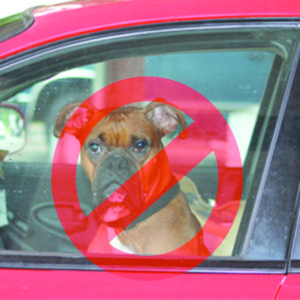 Learn how to protect your pet from the heat, stay cool, and prevent heatstroke.
Learn how to protect your pet from the heat, stay cool, and prevent heatstroke.
It’s important to protect pets from the heat to avoid heatstroke, which can be difficult to treat once it begins, and can be life threatening. Please observe and share the following guidelines and resources for keeping pets cool in hot weather.
Steps to keep your pets cool
• Don’t leave your pets in a parked car, even while running
• Make sure your pets have access to plenty of water at all times.
• Place some ice in their water bowl.
• Provide an outdoor pool filled with cool (but not cold) water.
• Know that pets are cooled primarily by panting and the pads of their paws, and fans do little to cool them off.
• Avoid excessive exercise with your pet in the heat.
• Seek air conditioning, shade, and avoid putting your pet in direct sunlight for long periods of time.
• If your pet appears to be panting excessively (or if your cat is panting at all), wrap them in a wet towel, and see the symptoms and treatment for Heatstroke below.
Pets in Hot Cars
If you see or hear about a pet in a hot car, it’s important to respond immediately. Lives are at stake.
• Call the Multnomah County Animal Services Dispatch at (503) 988-7387.
o Dispatchers will ask you about what you observe, and advise of next steps: Is the vehicle in the shade or the sun? Does the animal appear to exhibit any of the signs of heatstroke?
• Animal Control Officers and municipal police departments will respond to assist you.
• Citizens are legally permitted to enter a vehicle and remove pets or children in imminent danger of suffering harm if certain requirements are met, as per Oregon HB 2732. Multnomah County Animal Services or law enforcement must be notified of your emergency entry into the vehicle prior to or soon after the pets are removed. You must also remain with the removed pets in a safe location near the vehicle until Animal Services or law enforcement arrives.
Heatstroke Symptoms and Treatment for Dogs
Symptoms of heatstroke in dogs include excessive panting, glassy eyes, weakness, fast heart rate, drooling, seizures, vomiting, diarrhea, and a body temperature over 104 F. If you think your dog may have heatstroke, here’s what to do to help:
• Move your dog inside or to a shady spot.
• Submerge your dog in cool water (avoid cold water, which constricts blood vessels) or apply ice packs or cold towels to your dog’s chest, neck, and head. Don’t spray your dog with a yard hose — on hot days the water inside a hose can reach near boiling temperatures. You want to cool him off gradually.
• Give your dog cool, not cold, water. Or give him ice cubes to lick.
• After you’ve started cooling your dog down, take your dog to the vet immediately. Heatstroke can cause life-threatening damage to your pet’s internal organs if left untreated.
The best way to manage heatstroke is to avoid it. Never leave your pet in a parked car. It’s better to leave your pet at home than to risk heatstroke. At home, be sure to provide all pets with shade and water or a way to get inside during the hottest part of the day.
No Comments
Leave a comment Cancel